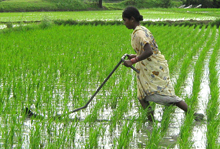Tuesday, April 23, 2024
News and Views from the Global South
DEVELOPMENT-INDIA:: Less Water, But More Rice
Manipadma Jena
- When French Jesuit priest and passionate agriculturist Henri de Laulanie developed the System of Rice Intensification (SRI) method of cultivation for Madagascar’s poor farmers in the 1980s, he probably had no idea that millions of farmers elsewhere in the world would one day benefit from it as well.

The Mandava weeder, a farmers' innovation, is lightweight and easy for women to use. Credit: Manipadma Jena/IPS
Ranging from new tools to the use of local materials to create organic fertilisers, these innovations have resulted in higher yields at lower costs for many rice farmers using SRI.
“SRI in India has often been made possible by small networks of innovators who have dared to experiment with an untested system of practices,” observes C Sambu Prasad, associate professor at Bhubaneswar’s Xavier Institute of Management.
“SRI is a farmer-to-farmer extension,” he adds. “Farmers experiment and their success convinces others to take up the innovations.”
India is considered by experts as among the original rice cultivating centres in the world. As in other Asian countries, rice remains a staple in this country, where some 44 millions of hectares are planted with the grain.
Conventional paddy cultivation practice consists mostly of raising seedlings in flooded nurseries for up to 30 days before these are transplanted. There is usually no regular spacing between clumps of plants, and inundation of the field is a must. Weeding is done manually.
By contrast, in the SRI method, single 12-day seedlings are transplanted at a precise spacing of 25-centimetre squares. The soil at the roots is also kept moist, well-aerated, and well-drained, while adding organic nutrients to it is encouraged. Frequent weeding is done with implements that also “churn” the soil, aerating it.
According to agriculture experts, this keeps the water requirement at a minimum. The attention paid to spacing the plants, meanwhile, means that the roots of each plant has enough room to grow, enabling it to flourish to its full grain-bearing potential.
SRI thus requires less seeds, water, and fertiliser even as it leads to greater yields.
Indeed, according to a comparative study by the Watershed Support Service and Activities Network (WASSAN), a non-profit organisation working with farmers here in the southeastern state of Andhra Pradesh, SRI results in returns that are 52 percent higher than those from convention cultivation. And while gross yield was 18 percent higher with SRI, total input costs were 32 percent lower.
WASSAN researcher S Bhagya Laxmi says the reduction in expenditure with SRI can be traced in large part to the 37-percent slash in labour costs for transplantation. More than half of these labour costs are for weeding, she says, but with the local SRI innovations, “twice as much time” was even freed up for the women who used to do the backbreaking work.
In Andhra Pradesh, SRI has already inspired the creation of at least two kinds of weeders.
One is called the cono-weeder, which was designed by scholars at the state Acharya N G Ranga Agricultural University. The other is the Mandava weeder, which was named after the home village of a group of farmers who found the cone-weeder too heavy and cumbersome for them to use.
Putting their heads together, the farmers led by 50-year-old Parcha Kishan Rao bent the main stem of the university-designed implement, and replaced the straight handle with a curved one from a bicycle. Instead of the cono-weeder’s single-toothed drum, the farmers’ version has two, making it lighter and far easier to push.
Today the Mandava weeder is being manufactured locally and sold for 800 rupees (18 dollars) each.
Bommi Reddy Sudhakar Reddy, who comes from the same rain shadow region as Rao and company, has also come up with a multi-row marker that saves time SRI farmers at the transplanting stage.
Prabhavathamma Reddy in Mahabubnagar district, for her part, says she is now harvesting nearly double what she used to get from her four-hectare land. She says it is because of SRI, but it could also be because she feeds her paddy with a five-ingredient organic fertiliser that she herself makes at home.
She has kindred spirits in Karnataka state in the country’s south-west, where fellow SRI farmer Narayana Reddy recounts how two of his friends are using neem leaves to ward off pests and sowing traditional seed varieties first soaked in cow’s milk.
“For strange reasons,” says WASSAN director K Suresh, “the rice intensification method has been evolving more within the domain of people’s knowledge and through farmer network innovations than through the formal science establishments.”
And ever-fresh ideas from farmers translate into higher yields, many more small-time rice-growers are getting attracted to SRI, which in 2009 was included by the federal government in the National Food Security Mission.
Vinod Goud, a scientist with the International Crop Research Institute for the Semi-Arid Tropics (ICRISAT), says more SRI farmers can only be good news at a time when climate change is wreaking havoc on crop yields. Through SRI, he adds, greater food self-sufficiency and resource – especially water – conservation are ensured.

 Print
Print



